Immerse yourself in biblical tales of brotherhood, where bonds and betrayals unfold, revealing profound insights into human connection and divine guidance.

Brotherhood in the Bible
Biblical brotherhood brings to bear bonds beyond blood, a theme threading through the tapestry of scripture. You'll find stories of sacrifice and support, as well as betrayal and bitterness, teaching timeless truths about human relationships and divine expectations.
From the fraternal fallout of Cain and Abel to the unbreakable bond between David and Jonathan, these narratives navigate the nuances of brotherhood. As you explore these stories, consider how they mirror the complexities of your own relationships and what they reveal about the nature of love, loyalty, and forgiveness.
The question then becomes, how do these ancient brotherhoods influence our understanding of community today?
Key Takeaways
- Brotherhood in the Bible showcases themes of rivalry, forgiveness, and redemption through stories like Cain and Abel, and Joseph and his brothers.
- Biblical narratives emphasize the deep bonds of platonic love and loyalty, as seen in the friendship between David and Jonathan.
- Leadership and partnership are illustrated through figures like Moses and Aaron, highlighting the strength and effectiveness of brotherhood in achieving divine missions.
- The Bible presents brotherhood as a foundation for community support and spiritual growth, evident in the early Christian community and teachings like "Love Thy Neighbor."
The Story of Cain and Abel
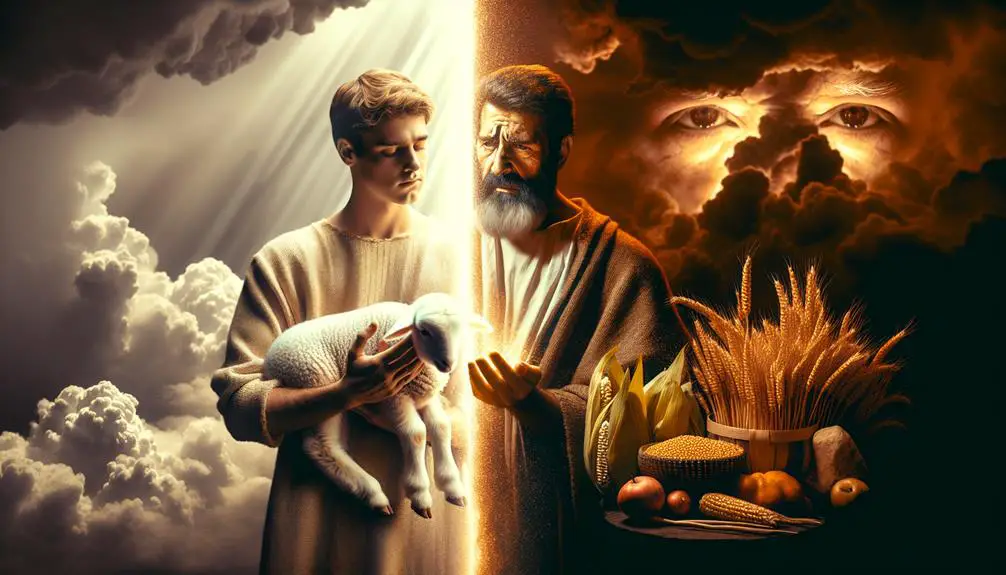
In the biblical narrative, the story of Cain and Abel presents a profound exploration of fraternal dynamics and moral failure. You're immediately introduced to the concept of sibling rivalry, a theme that's as old as humanity itself. This tale, nestled in the early chapters of Genesis, isn't just a simple account of jealousy and murder; it's a complex study of human nature, divine justice, and the consequences of our actions.
You see, Cain and Abel, the first sons of Adam and Eve, bring offerings to God. Abel's sacrifice, a lamb, is accepted, but Cain's offering, produce from the ground, is not. This rejection ignites a spark of jealousy in Cain. Instead of seeking to improve his standing or understand his failure, Cain allows his envy to fester into something far more sinister.
As you delve deeper into the narrative, you can't help but ponder the lesson on divine justice. God's reaction to Cain's deed isn't immediate obliteration but rather a mark of protection, despite the punishment of exile. This peculiar form of justice highlights God's mercy and the complexity of His judgment. It suggests that even in the wake of grave sin, there's room for repentance and redemption.
The story of Cain and Abel serves as a timeless reminder of the destructive potential of unchecked jealousy and the importance of striving for righteousness in our offerings to God. It encourages you to reflect on your own relationships and the ways in which you seek divine favor, emphasizing that the true path to acceptance lies in the purity of your offerings and the integrity of your heart.
Joseph and His Brothers
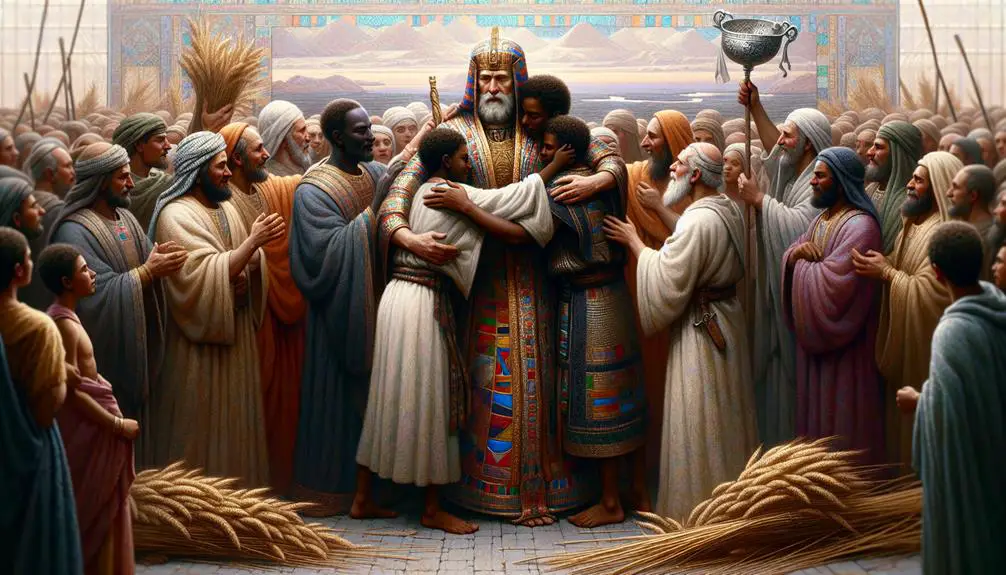
Exploring further the dynamics of brotherhood within the biblical context, the story of Joseph and his brothers offers a rich tapestry of betrayal, forgiveness, and divine providence. This narrative encapsulates not only the complexities of sibling relationships but also the profound ways in which divine plans unfold through human actions.
- Sibling Rivalry: At the heart of Joseph's story is the intense sibling rivalry fueled by jealousy. Joseph, favored by his father Jacob, becomes the target of his brothers' envy, especially after sharing his dreams, which suggest his future dominance over them.
- Dream Interpretation: Joseph's ability to interpret dreams plays a pivotal role in his journey from a pit in Canaan to the palaces of Egypt. This unique skill not only saves Egypt from famine but also sets the stage for a dramatic family reunion.
- Betrayal and Forgiveness: The narrative takes a dark turn when Joseph's brothers sell him into slavery. Yet, it's through this betrayal that Joseph's journey towards becoming a key figure in Egypt begins. The eventual reconciliation and forgiveness between Joseph and his brothers illustrate the possibility of redemption and healing within family dynamics.
- Divine Providence: The story underscores the theme of divine providence, suggesting that even in the midst of suffering and injustice, there's a greater plan at work. Joseph's rise to power and the fulfillment of his early dreams underscore a belief in the purposeful guidance of God's hand over individual lives.
Analyzing the story of Joseph and his brothers, you're invited to reflect on the intricate interplay between human free will and divine intervention, and how forgiveness can emerge from the depths of betrayal.
Moses and Aaron's Partnership
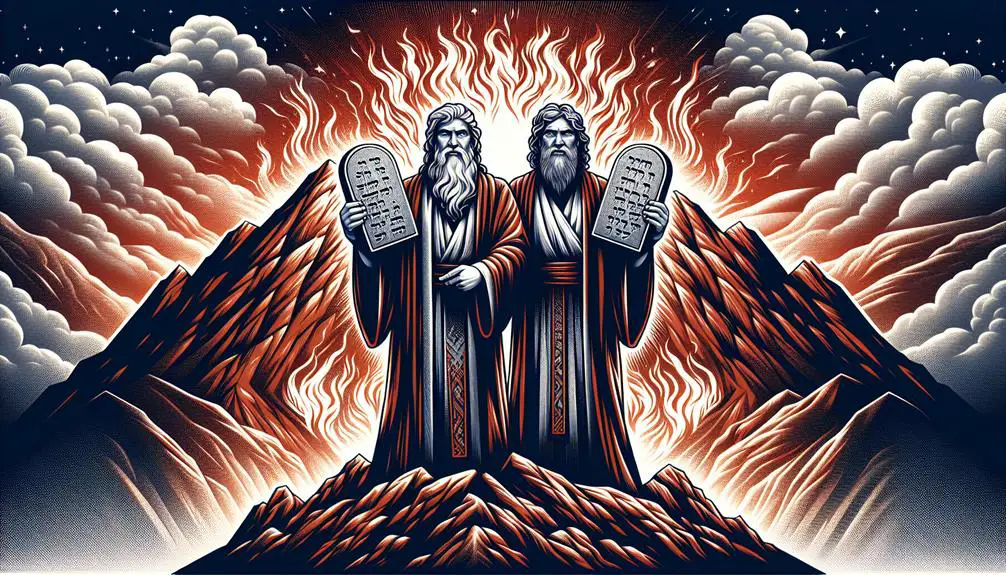
How do Moses and Aaron's partnership exemplify a divine orchestration of leadership and brotherhood in the fulfillment of Israel's liberation? Their collaboration showcases a profound intertwining of leadership dynamics and spiritual brotherhood, unique in biblical narratives. You'll find that their roles weren't merely assigned by familial ties but were divinely appointed, each complementing the other in ways that underscore their individual strengths and weaknesses.
Moses, with his direct connection to God and his moral authority, was the visionary leader, while Aaron, his older brother, played the indispensable role of spokesperson and intermediary. This partnership wasn't without its challenges; however, it's in navigating these difficulties that the depth of their spiritual brotherhood shines brightest. They leaned on each other, demonstrating trust and faith not only in God but in one another. This reliance on each other was critical in leading the Israelites out of bondage.
Their story is a testament to the power of combined strengths in leadership. Aaron's eloquence and Moses' unyielding faith created a synergy that propelled the Israelite community towards freedom. This narrative teaches us the importance of recognizing and valuing different leadership qualities and the strength found in spiritual brotherhood.
In analyzing Moses and Aaron's partnership, you're encouraged to reflect on the broader implications of their relationship. It serves as a vivid example of how leadership, when rooted in mutual respect, faith, and brotherhood, can achieve divine purposes. Their story isn't just historical; it's instructional, offering insights into the essence of effective leadership and the unbreakable bonds of spiritual brotherhood.
David and Jonathan's Friendship

Delving into the story of David and Jonathan, we uncover a profound example of friendship that transcends mere political alliance or familial duty, embodying instead a deep, covenantal bond marked by loyalty, respect, and love. Their relationship in the biblical narrative is a testament to how friendship can mirror divine love and commitment, setting a benchmark for brotherhood that stretches beyond the confines of blood relations.
To paint a picture for you:
- Jonathan recognized David's anointing by God and chose to support him, even knowing it might cost him his claim to the throne. This act signifies a loyalty that puts divine will and friendship above personal ambition.
- Despite King Saul's intent to kill David, Jonathan warned him, risking his own safety to protect his friend. This moment underscored the loyalty tested and the unbreakable bond between them.
- They made a covenant before the Lord, which wasn't just a formal agreement but a sacred vow that showcased the spiritual depth of their relationship. This covenant further solidified their commitment to each other, transcending typical friendship expectations.
- Jonathan's love for David was described as greater than that for women, indicating a platonic yet intensely deep affection that surpassed the norms of their time.
Their story isn't just a historical account but a lesson in the power of a friendship grounded in faith, loyalty, and mutual respect. Jonathan and David's relationship teaches us about the strength of bonds formed not just in times of peace but, importantly, through trials, making their story an enduring example of an unbreakable bond.
The Prodigal Son Parable
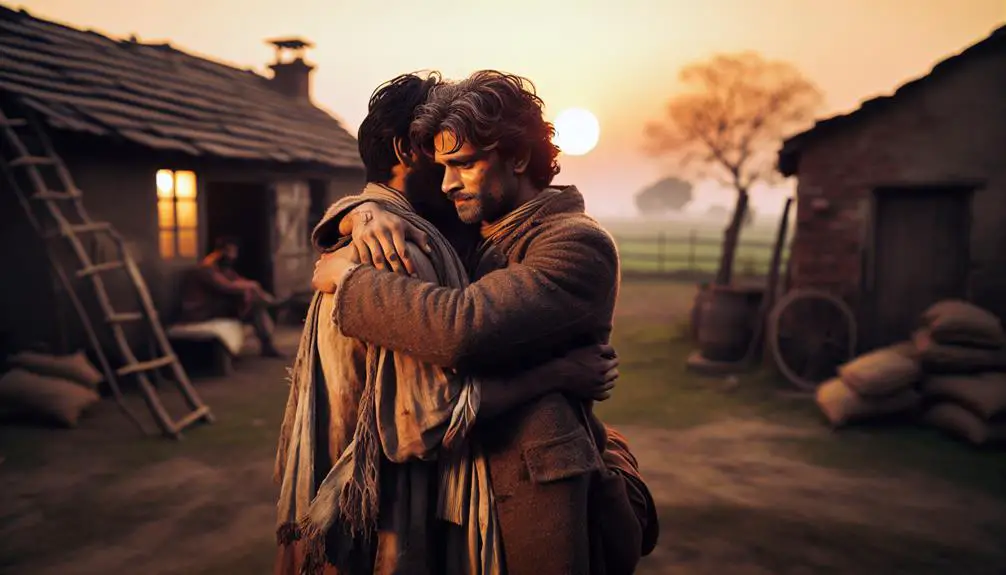
While the story of David and Jonathan exemplifies the strength of covenantal bonds, the Parable of the Prodigal Son shifts the focus to the dynamics of forgiveness and reconciliation within a family context. This parable, rich with themes of mercy, redemption, and familial ties, offers a profound exploration of the father's mercy and the complexities of sibling rivalry.
You'll find that the father's unconditional love and forgiveness towards his wayward son illuminates the boundless nature of divine mercy. The younger son's demand for his inheritance, followed by squandering his wealth, symbolizes human folly and estrangement from one's roots. Yet, upon his return, the father's immediate and lavish welcome underscores the limitless capacity for forgiveness, a cornerstone of familial and divine love.
However, the elder son's reaction introduces the theme of sibling rivalry and jealousy. His resentment towards the celebration of his brother's return reflects a common human predicament: the struggle to rejoice in others' redemption and success, especially when it seems unearned. This aspect of the parable prompts you to reflect on the nature of grace and the challenge of embodying genuine brotherly love, even in the face of perceived injustice.
In analyzing the Parable of the Prodigal Son, you're encouraged to consider how the themes of father's mercy and sibling rivalry aren't merely ancient texts but resonate deeply with modern experiences of family dynamics. This parable serves as a timeless reminder of the power of forgiveness and the complexity of human relationships within the context of brotherhood.
Peter, James, and John

In the heart of the New Testament, Peter, James, and John emerge as pivotal figures whose close relationship with Jesus offers profound insights into the nature of discipleship and brotherhood. You'll find that their experiences, particularly as part of Jesus' inner circle, provide a unique lens through which to view the complexities and privileges of being close to the Messiah.
- Inner circle dynamics: Peter, James, and John were often singled out by Jesus for experiences that the other disciples didn't share, highlighting the trust and special roles they played.
- Transfiguration witnesses: They alone were present at the Transfiguration of Jesus, a seminal event where Jesus' divine nature was revealed in a new way, underscoring their unique position within the discipleship.
- Garden of Gethsemane: In Jesus' moment of profound distress before His crucifixion, these three were asked to stay awake and pray, showcasing their role as not just followers but intimate companions in Jesus' most trying time.
- Leadership roles post-Resurrection: Their experiences and the insights gained from their close relationship with Jesus positioned them as key leaders in the early Christian community, shaping the faith's development and spread.
Analyzing their journey reveals that their brotherhood wasn't just about shared experiences but was deeply rooted in spiritual growth, personal transformation, and the spread of Jesus' teachings. Their story teaches us about the depth of faith, the importance of close relationships in spiritual journeys, and the responsibilities that come with being part of Jesus' inner circle. Through them, we understand the essence of discipleship and brotherhood in the Christian faith.
The Early Christian Community
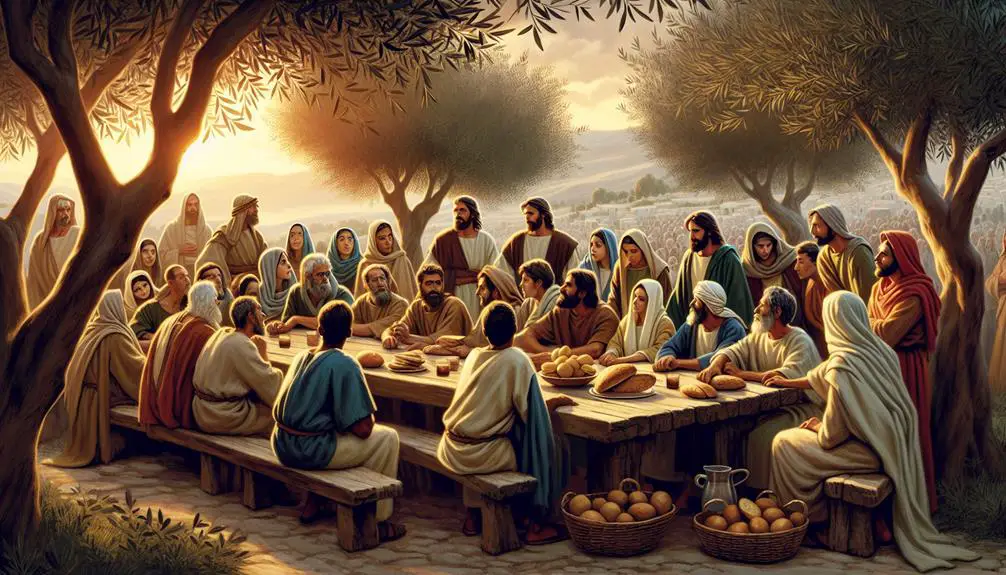
ARTICLE TITLE: Brotherhood in the Bible
PREVIOUS SUBTOPIC: 'Peter, James, and John'
CURRENT SUBTOPIC: 'The Early Christian Community'
After the resurrection of Jesus, the early Christian community quickly took shape, forming a tight-knit brotherhood rooted in shared beliefs and collective mission. This nascent group distinguished itself through a profound commitment to communal sharing and unwavering dedication to Apostolic missions. Their lives were testament to a revolutionary way of living that prioritized the collective well-being over individual gain.
Aspect |
Description |
Impact |
|---|---|---|
Communal Sharing |
Resources were pooled together, ensuring no one was in need. |
Fostered unity and trust. |
Apostolic Missions |
Spreading the teachings of Jesus far and wide. |
Expanded the community's reach. |
Brotherhood |
A deep sense of connection and mutual support. |
Strengthened their resolve. |
This table encapsulates the essence of the early Christian community, evoking a sense of awe at their commitment and the depth of their brotherhood. Their actions, driven by faith and a shared vision, laid the foundations for what would become a global faith community.
The concept of communal sharing was not merely about the redistribution of material goods but a testament to their understanding of equality and shared destiny. Similarly, Apostolic missions were not just about spreading a message but about creating a universal brotherhood that transcended geographical, cultural, and ethnic boundaries.
The early Christian community's story is a powerful reminder of the potential of collective faith and action. It challenges you to reflect on the values of brotherhood, sharing, and mission in your own lives, encouraging a reevaluation of priorities in favor of a more communal and purpose-driven existence.
Love Thy Neighbor Commandment

Reflecting on the early Christian community's commitment to unity and shared mission, it's evident how the 'Love Thy Neighbor Commandment' further encapsulates their ethos of brotherhood and mutual support. This commandment, central to the teachings of Jesus, underscores the Golden rule, “Do unto others as you'd have them do unto you,” offering a profound directive for interpersonal relationships.
To understand this commandment's depth, consider these aspects:
- The universal scope of 'neighbor': It transcends cultural, religious, and social boundaries, advocating for an inclusive approach to compassion and empathy.
- The Samaritan example: Jesus' parable of the Good Samaritan redefines the concept of neighborliness, illustrating that acts of kindness aren't confined within one's community but extend to all, even to those regarded as outsiders or enemies.
- The transformative power of love: Genuine love for one's neighbor has the capacity to break down barriers, foster mutual respect, and create a sense of belonging and community.
- The reflection of divine love: This commandment mirrors the unconditional love God has for humanity, encouraging believers to emulate this divine quality in their relationships.
Analytically, the 'Love Thy Neighbor Commandment' isn't merely an ethical directive but a foundational principle that shapes the character of Christian communities. It challenges individuals to live out their faith through actionable love, setting a standard for how believers interact with those around them. By embodying this commandment, Christians not only adhere to a key tenet of their faith but also contribute to a more compassionate and understanding world.
Frequently Asked Questions
How Does the Concept of Brotherhood in the Bible Relate to Modern-Day Sibling Relationships and Conflicts?
You'll find that sibling dynamics and modern conflicts often reflect themes seen in historical or religious texts. Analyzing these relationships, it's clear that the challenges and bonds you face with your siblings aren't new. They're deeply rooted in human nature, echoing tales of cooperation, rivalry, and reconciliation.
Understanding this connection helps navigate your own sibling relationships, offering a perspective that's both scholarly and faithful to the complexities of family life.
In What Ways Does the Bible Address Brotherhood Beyond Blood Relations, Especially in the Context of Mentorship and Discipleship?
You'll find the Bible goes beyond blood ties, emphasizing spiritual adoption and Apostolic relationships, which are key to understanding mentorship and discipleship.
It's not just about being related; it's about forming deep, spiritual connections. Through teachings and examples, such as Paul's guidance to Timothy, you're shown how these relationships shape faith and leadership.
This approach highlights a broader, more inclusive concept of brotherhood, rooted in shared beliefs and mutual support.
How Do Biblical Teachings on Brotherhood Influence Contemporary Notions of Community Service and Social Justice?
Like seeds sown in fertile ground, biblical teachings on brotherhood have blossomed into contemporary movements of charitable generosity and social activism.
You'll find these ancient principles woven into the fabric of modern community service, urging you to act justly and love mercy.
They serve as a compass, guiding your efforts in social justice, ensuring your actions aren't just about meeting needs but about nurturing a global family bound by compassion, not just blood.
Can the Principle of Brotherhood in the Bible Provide Guidance on Navigating Rivalry and Competition in Professional Settings?
Absolutely, the principle of brotherhood can guide you through rivalry and competition in your career. It encourages viewing colleagues as allies, not adversaries, fostering a workplace ethic of mutual respect and support.
This approach doesn't just enhance individual career advancement; it cultivates a healthier, more collaborative environment.
How Is the Theme of Brotherhood Utilized to Address Issues of Forgiveness and Reconciliation in the Bible, Outside of the Well-Known Parables and Stories?
Exploring themes beyond popular narratives like the Prodigal Son, you'll find the Bible rich with insights on divine forgiveness.
It subtly weaves forgiveness and reconciliation throughout its tapestry, demonstrating how these acts transcend mere familial ties, promoting a broader sense of unity.
This approach encourages you to see beyond personal grievances, embracing a more inclusive perspective of brotherhood, where understanding and peace are paramount, guiding you towards a path of true reconciliation.
Conclusion
In exploring the tapestry of brotherhood woven throughout the Bible, you've journeyed through narratives of unity and division, loyalty and betrayal. From the earth's first heartbreak between Cain and Abel to the early Christian community's embrace, these stories offer profound insights into human relationships and divine wisdom.
They teach us to cherish the bonds of brotherhood, navigating the complex dance of human interactions with grace. In essence, they guide us to fulfill the divine commandment of loving our neighbors, enriching our spiritual journey.



Sign up